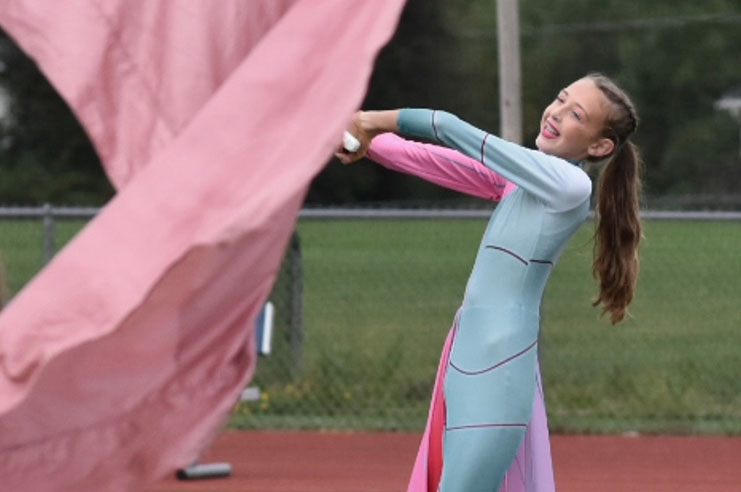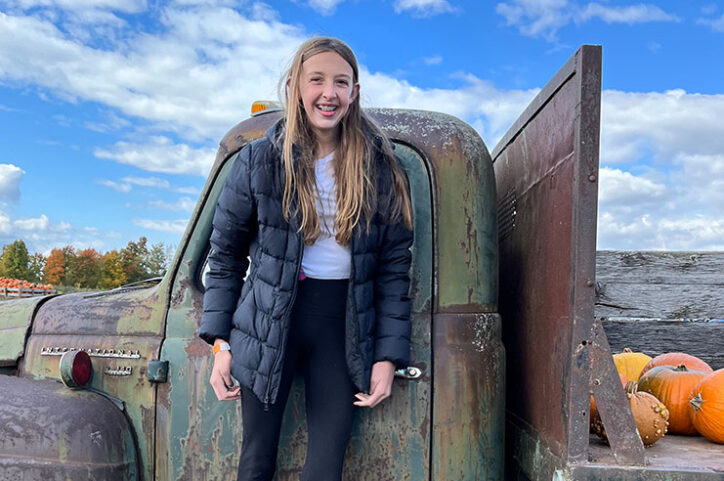Chloe navigates Marfan syndrome with a positive attitude — and a responsive care team

Chloe Burian has always defied expectations. Despite surgeries and other treatments for several conditions that stem from the genetic disorder Marfan syndrome, the 12-year-old remains upbeat.
“Nothing bothers her,” says Chloe’s mom, Audrey. “She goes through life with a smile.”
Still, there were moments of doubt along the way, especially when Audrey and her husband, Rudy, recognized signs of Marfan syndrome when Chloe was younger. They realized they had to find a hospital outside their hometown of Syracuse, N.Y., that could treat the many different aspects of the disorder. They wanted to get Chloe healthy so she could chase her dreams.
Chloe initially gets treatment but not holistic care
Only hours after being delivered through an emergency C-section, Chloe needed a blood transfusion. She also received a low score on the Apgar test, an evaluation clinicians make of newborns’ appearance, muscle tone, movement, and other measurements of well-being. “We didn’t know what the future was going to hold for Chloe,” Audrey recalls.
Audrey often thought about the Apgar score as Chloe grew and experienced more health issues. As Chloe learned how to walk, her parents noticed her right foot turned inward almost at a 90-degree angle. An orthopedist recommended a neurologist, whose diagnosis led Chloe to have surgery that removed three cysts from her spine and treated a tethered spinal cord. Chloe’s foot didn’t straighten, however, and another surgery was scheduled.
Audrey had doubts: “I kept thinking there’s something else going on, and I can’t put my finger on it.” She searched online and discovered that many of Chloe’s physical characteristics and symptoms — curved spine, tall stature and thin frame, foot misalignment, crowded teeth — matched those associated with Marfan syndrome. The disorder weakens the connective tissues that support the body’s bones, muscles, and organs, so complications with the heart and blood vessels are also common.

When Audrey recognized the totality of Marfan syndrome, especially how it can potentially cause life-threatening heart problems, she was determined to find a hospital that could diagnose Chloe and, as she anticipated, coordinate care among the different specialists who treat Marfan syndrome.
A new diagnosis starts a coordinated approach to treatment
Audrey’s research pointed her to a Boston Children’s web page devoted to the disorder, so one day she called the hospital. “The person who answered was amazing,” she recalls. “I thought she was going to hang up and be like, ‘This one is crazy.’ But she said, ‘Hold on. Has your daughter had a cardiac test?’” It wasn’t long before Chloe, then 4, had appointments with various Boston Children’s clinicians who treat and help manage Marfan syndrome, including specialists in Cardiology, Orthopedics, Neurology, and Ophthalmology.
The hospital’s Center for Cardiovascular Genetics coordinates Chloe’s care. A co-director of the center, Dr. Amy Roberts, has been a valuable source of information and comfort for the family after genetic testing confirmed Chloe has Marfan syndrome. “I’ll always remember, after we got the test results, Dr. Roberts telling me it’s not our fault,” Audrey says. “She walked me through it all and I realized this is good because now we know.”
Audrey also couldn’t be happier with the coordination between specialists. “Doctors had answers for me, and if they didn’t, they would acknowledge it and send me somewhere else in the hospital to get answers. It’s amazing how they work as a team.”
Helping Chloe go where she wants to go, including Harvard
Chloe has had several surgeries at Boston Children’s. Dr. Daniel Hedequist, a surgeon and chief of the Spine Division, fused her spine. Dr. Collin May, a surgeon at the Orthopedic Center and its Lower Extremity Program, determined Chloe had severe skewfoot. It’s a congenital condition that causes foot bones to curve in and ankle bones to misalign, creating a Z-shaped or serpentine foot. Dr. May straightened her foot through several procedures. Audrey recalls, “I’ll never forget what he said to us: ‘I’d love you to come on this journey with me.’ He knew he could get her where she needed to go.”
That journey will continue as Chloe starts receiving care for her heart. Dr. Kristin Bonello, a cardiologist, and other heart specialists at the hospital’s Benderson Family Heart Center diagnosed her with a form of mitral valve disease that will need constant monitoring and potentially surgical repair.

In the meantime, Chloe focuses on her seventh-grade classes including her favorites, math and social studies. She’s not yet sure what kind of career she will pursue but is certain she wants to attend Harvard University.
Following in her older sister Abby’s footsteps, she just made the varsity squad of her middle school’s color guard, a team that performs choreographed dances at events. That takes up a lot of Chloe’s time, but she still finds energy for swimming and hanging out with friends.
Even though it’s a five-hour car ride, she always looks forward to visiting Boston and her center of care. “I really like Boston Children’s,” Chloe says. “I feel like I’m home.”
Learn more about the Center for Cardiovascular Genetics or schedule an appointment.
Related Posts :
-

Using genetics to glimpse newborns' future with congenital heart disease
Aside from infections, congenital heart disease (CHD) is the leading cause of infant mortality. Informed by babies she sees in ...
-

Coordinated care and research for genetic cardiovascular disorders
Genetic cardiovascular disease in children sometimes comes to light in a crisis — a sudden collapse, sudden breathing difficulty, a sudden ...
-

With support for genetic condition trisomy 18, Brooklyn ‘tells her own story’
Erin and Tim Haggan quickly realized they would always be seeking answers after learning the child they were expecting had&...
-

Research aims to pinpoint genetic connection between autism and heart disease
Cardiology and neurodevelopmental researchers have more questions than answers about the possible genetic links between congenital heart disease (CHD)&...





